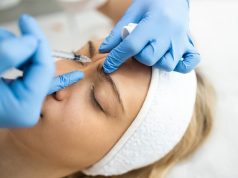The 73rd Annual Meeting of the American Academy of Dermatology
The annual meeting of the American Academy of Dermatology was held from March 20 to 24 in San Francisco and attracted more than 15,000 participants from around the world, including clinicians, academicians, allied health professionals, and others interested in dermatology. The conference highlighted recent advances in the diagnosis and management of dermatological conditions.
In one presentation, Debjani Sahni, M.D., of the Boston University School of Medicine, discussed how targeted therapy and immunotherapy are effective options for patients with advanced melanoma. The targeted therapy drugs currently available that have been shown to improve survival in melanomas include BRAF-inhibitors (BRAFi) and MEK-inhibitors (MEKi).
“For melanomas that carry the BRAF mutation, the use of a BRAFi in combination with a MEKi improves the response rate and also delays the time to develop resistance. Thus the use of the BRAFi, MEKi combination for melanomas with a BRAF mutation is currently the standard of care,” Sahni said.
Immunotherapy is an alternative approach to treating advanced melanoma. “Immunotherapy works by harnessing the body’s own immune system, and potentiating it to recognize and kill cancer better,” Sahni said. “Unlike targeted therapy, immunotherapy drugs can produce a durable response that can last several years (in excess of five years), and may even be a potential cure (though at present we don’t have enough long-term data to substantiate the latter point).”
The downside of the immunotherapy drugs is that only a small proportion of patients respond to them. “The current challenge for physicians is to be able to predict which patients are likely to respond to these drugs, and a better understanding of the mechanisms that allow cancers to evade elimination by the body’s immune system is likely to help us understand this better in the future,” Sahni said. “The treatment landscape for advanced melanoma is rapidly changing and is moving towards a more personalized approach, utilizing drug combinations that individual patients are most likely to benefit from.”
Iltefat Hamzavi, M.D., of the Henry Ford Hospital in Detroit, provided insight into the emotional and physical burden of vitiligo and discussed recent research efforts linking other physical conditions to the condition.
Over a 10 year period, Hamzavi and colleagues found that approximately 20 percent of 1,098 vitiligo patients evaluated had at least one additional autoimmune disease, with thyroid disease and alopecia areata being the most prevalent. Therefore, it is important for physicians to be aware of the potential for comorbid autoimmune diseases in patients with vitiligo.
“Vitiligo is often perceived to be ‘only a cosmetic condition,’ but it’s not just a disease of the skin,” Hamzavi said in a statement. “While the skin is a primary target, other organs are also at risk, and the emotional effects on patients can be devastating.”
Mary P. Lupo, M.D., of the Tulane University School of Medicine in New Orleans, discussed how exfoliation may improve a patient’s skin appearance and make topical treatments more effective. However, every type of exfoliation may not work for every skin type, which is why it is necessary for patients to consult with a dermatologist who is knowledgeable about skin types and different exfoliation methods.
“There are circumstances where certain methods are better than others and certain presentations where one method of exfoliation is not advised,” Lupo said. “Dermatologists need to understand the different methods for exfoliation in order to best advise and treat patients.”
Lupo highlighted the short- and long-term benefits of exfoliation, discussing how increased collagen production can result in younger looking skin over the longer term. In addition, Lupo talked about how microdermabrasion and chemical peels are excellent for photoaging, active acne and rosacea, and hyperpigmentation.
AAD: Herpes Zoster Incidence Up With Combo Tx for Psoriasis
MONDAY, March 23, 2015 (HealthDay News) — For patients with psoriasis, combination treatment with biologic medications and methotrexate is associated with increased incidence of herpes zoster (HZ), according to a study published online March 22 in JAMA Dermatology. The research was published to coincide with the annual meeting of the American Academy of Dermatology, held from March 20 to 24 in San Francisco.
AAD: Telangiectatic Photoaging Distinct From Rosacea Subtype
MONDAY, March 23, 2015 (HealthDay News) — Telangiectatic photoaging (TP) is a distinct dermatological disorder from erythematotelangiectatic subtype of rosacea (ETR), according to a study published online March 23 in JAMA Dermatology. The research was published to coincide with the annual meeting of the American Academy of Dermatology, held from March 20 to 24 in San Francisco.
AAD: Low Rate of Hyperkalemia With Spironolactone Use
MONDAY, March 23, 2015 (HealthDay News) — Healthy young women taking spironolactone for acne have no increased rate of hyperkalemia, according to a study published online March 22 in JAMA Dermatology to coincide with the annual meeting of the American Academy of Dermatology, held from March 20 to 24 in San Francisco.
AAD: Study Examines Incidence of Non-Melanoma Skin Cancer
FRIDAY, March 20, 2015 (HealthDay News) — The incidence of non-melanoma skin cancer (NMSC) is much higher for Caucasians than Hispanics or Asians, but Hispanic patients are significantly younger than Caucasian or Asian patients, according to research presented at the annual meeting of the American Academy of Dermatology, held from March 20 to 24 in San Francisco.
Copyright © 2015 HealthDay. All rights reserved.







